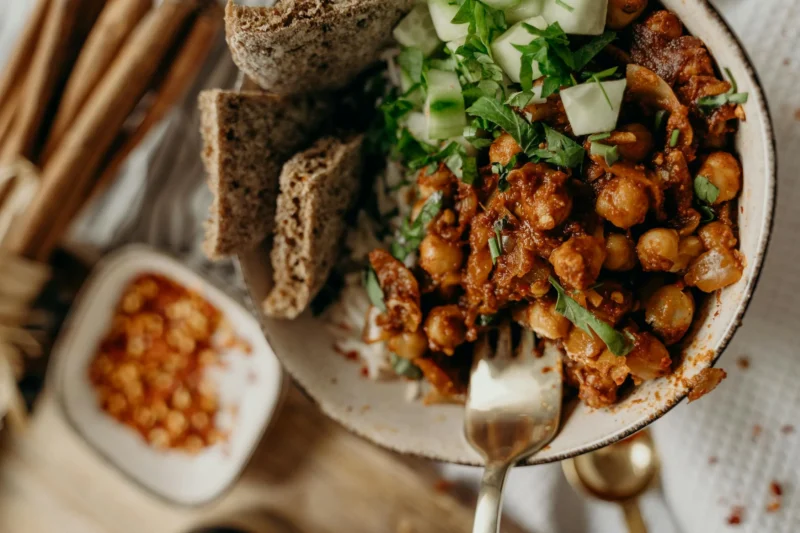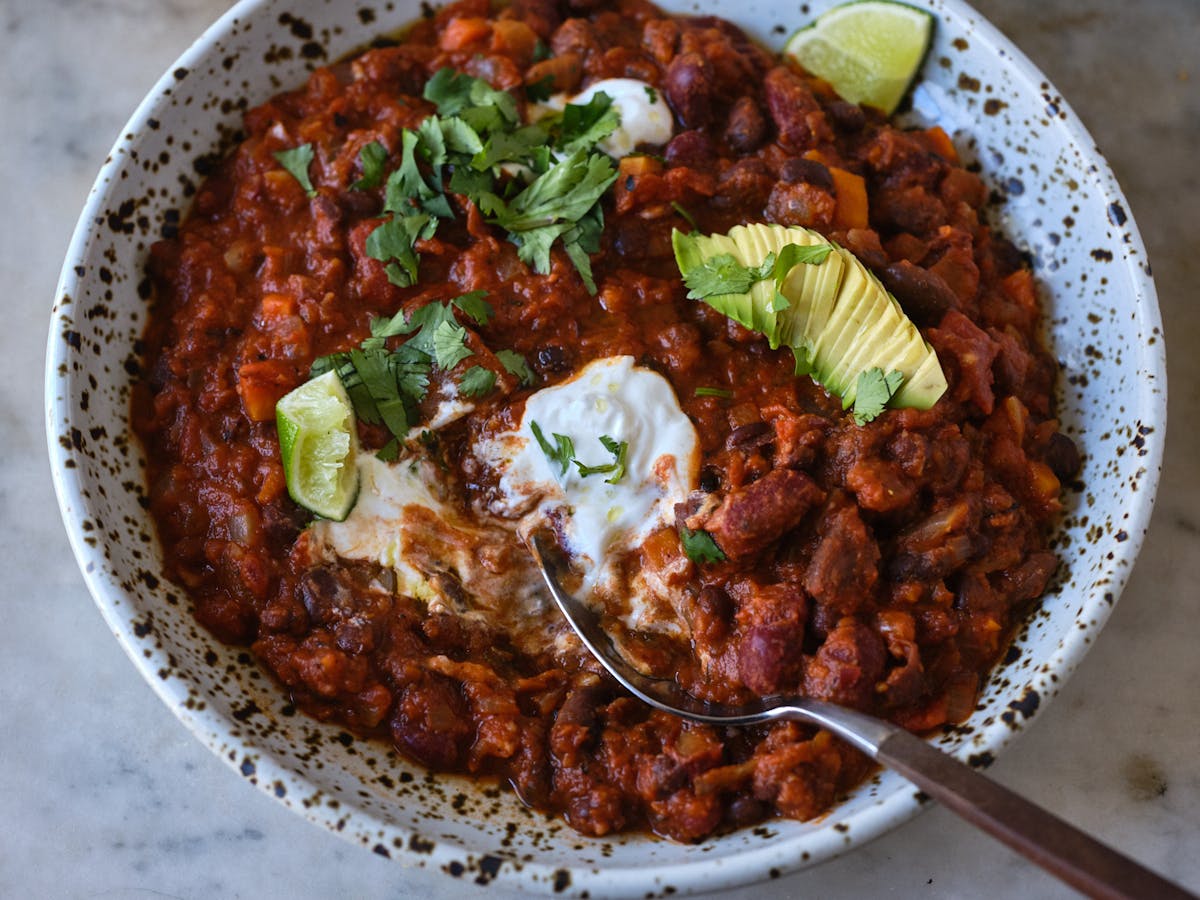
To make vegetarian chili, sauté onions and garlic, then add beans, tomatoes, and spices. Simmer until thickened.
Vegetarian chili recipe is a hearty, flavorful dish perfect for any meal. It’s packed with protein-rich beans, fresh vegetables, and aromatic spices. This easy-to-make recipe is ideal for busy weeknights or casual gatherings. You can enjoy it as a standalone meal or serve it with rice, cornbread, or tortilla chips.
The combination of ingredients ensures a satisfying, nutritious dish that everyone will love. Preparing vegetarian chili at home allows you to control the ingredients, making it a healthier choice. Whether you’re a seasoned cook or a kitchen newbie, this vegetarian chili recipe is straightforward and rewarding. Enjoy a warm bowl of delicious vegetarian chili any time of the year.
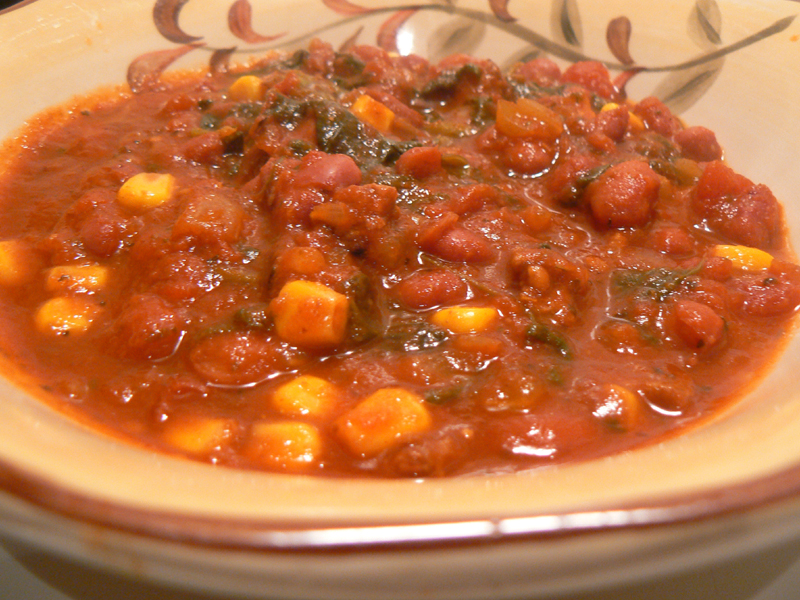
Ingredients List
Vegetarian chili is a flavorful and hearty dish that satisfies the taste buds. The secret to a great vegetarian chili lies in the ingredients. A well-thought-out ingredients list ensures you get the right textures and flavors in every bite. Let’s dive into the essential components of this delicious recipe.
Fresh Vegetables
Fresh vegetables bring vibrant colors and essential nutrients to your vegetarian chili. They add crunch and freshness that canned or frozen veggies can’t match. Here’s a list of must-have fresh vegetables for your chili:
- Bell Peppers: Use a mix of red, green, and yellow bell peppers for a colorful dish.
- Onions: White or yellow onions add sweetness when cooked.
- Garlic: Fresh garlic cloves provide a bold, aromatic flavor.
- Tomatoes: Use ripe tomatoes for a juicy base.
- Carrots: Diced carrots add a slight sweetness and crunch.
- Celery: Chopped celery adds a subtle flavor and crunch.
- Zucchini: Adds a soft texture and absorbs the chili’s flavors well.
Beans And Legumes
Beans and legumes are the backbone of vegetarian chili. They provide protein and make the dish hearty and filling. Here are the best options for your chili:
- Kidney Beans: These beans are firm and hold up well in chili.
- Black Beans: They add a rich, earthy flavor.
- Pinto Beans: Pinto beans are creamy and absorb flavors well.
- Lentils: Green or brown lentils add a meaty texture.
- Chickpeas: Chickpeas add a slightly nutty flavor and firm texture.
| Bean/Legume | Quantity (cooked) |
|---|---|
| Kidney Beans | 1 cup |
| Black Beans | 1 cup |
| Pinto Beans | 1 cup |
| Lentils | 1 cup |
| Chickpeas | 1 cup |
Spices And Herbs
Spices and herbs are crucial in creating the rich, bold flavors of vegetarian chili. They transform basic ingredients into a savory masterpiece. Here’s what you need:
| Spice/Herb | Quantity |
|---|---|
| Chili Powder | 2 tbsp |
| Cumin | 1 tbsp |
| Oregano | 1 tsp |
| Smoked Paprika | 1 tsp |
| Ground Coriander | 1 tsp |
| Salt | To taste |
| Pepper | To taste |
| Bay Leaves | 2 leaves |
| Fresh Cilantro | For garnish |
How To Prepare Vegetarian Chili
Making a delicious vegetarian chili starts with proper preparation. Taking the time to prepare ingredients well ensures rich flavors and a hearty texture. Follow these preparation steps for a perfect vegetarian chili.
Also Read: Healthy Creamy Mushroom Soup Recipe For Dinner
Chopping Vegetables
First, gather all the vegetables you need for the chili. Fresh vegetables make your chili tasty and nutritious. You will need onions, bell peppers, carrots, and celery. These vegetables add a wonderful base to your chili.
Chop the onions finely. They should be small enough to melt into the chili while cooking. Dice the bell peppers into small, even pieces. This ensures they cook evenly. Carrots and celery should be chopped into bite-sized chunks. Use a sharp knife for clean cuts, making the work easier and safer. Here’s a quick guide for chopping:
- Onions: Finely chop 2 medium onions
- Bell Peppers: Dice 2 bell peppers (any color)
- Carrots: Chop 2 large carrots into small chunks
- Celery: Chop 2 stalks of celery into small pieces
Place all chopped vegetables into separate bowls. This helps with easy access when you start cooking.
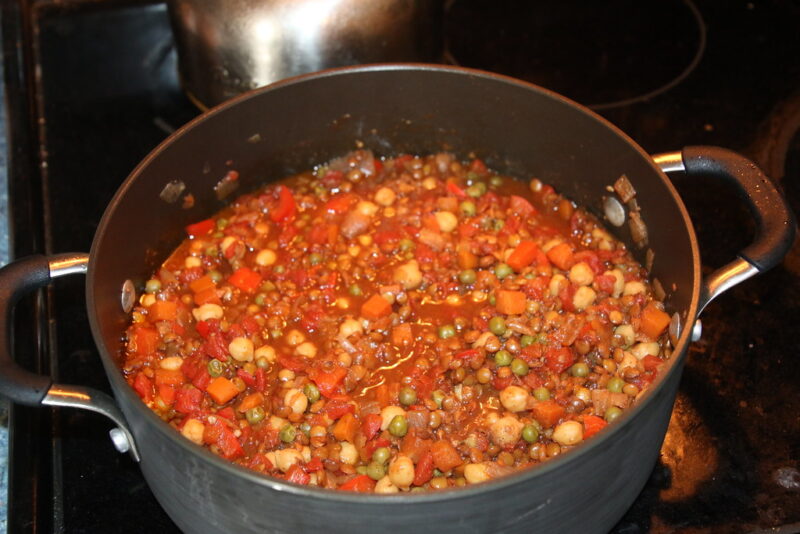
Measuring Ingredients
For a balanced and flavorful chili, measure your ingredients accurately. Use measuring cups and spoons for precision. This step avoids over-seasoning or under-seasoning your chili. Here’s a list of common ingredients and their measurements:
| Ingredient | Measurement |
|---|---|
| Olive Oil | 2 tablespoons |
| Garlic | 4 cloves, minced |
| Chili Powder | 2 tablespoons |
| Ground Cumin | 1 tablespoon |
| Tomato Paste | 2 tablespoons |
| Crushed Tomatoes | 1 can (28 ounces) |
| Vegetable Broth | 2 cups |
Prepare all your spices and liquids beforehand. Place them in separate small bowls or containers. This makes adding them to the pot quick and easy.
Read More:9 Simple Spaghetti Recipe For Dinner
Prepping Beans
Beans are a crucial part of vegetarian chili. They add protein and texture. You can use canned beans or dried beans. If using canned beans, drain and rinse them well. This removes excess sodium and makes them taste better.
For dried beans, soak them overnight. Use a large bowl and cover the beans with water. The next day, drain and rinse the beans. Cook them in fresh water until they are tender. This step may take about an hour. You can use a slow cooker or pressure cooker for faster results. Here are the types of beans you can use:
- Kidney Beans: 1 can or 1 cup dried beans
- Black Beans: 1 can or 1 cup dried beans
- Pinto Beans: 1 can or 1 cup dried beans
Combine different beans for a rich and varied texture. This makes your chili hearty and filling. Place the prepped beans in a bowl, ready to add to your chili.
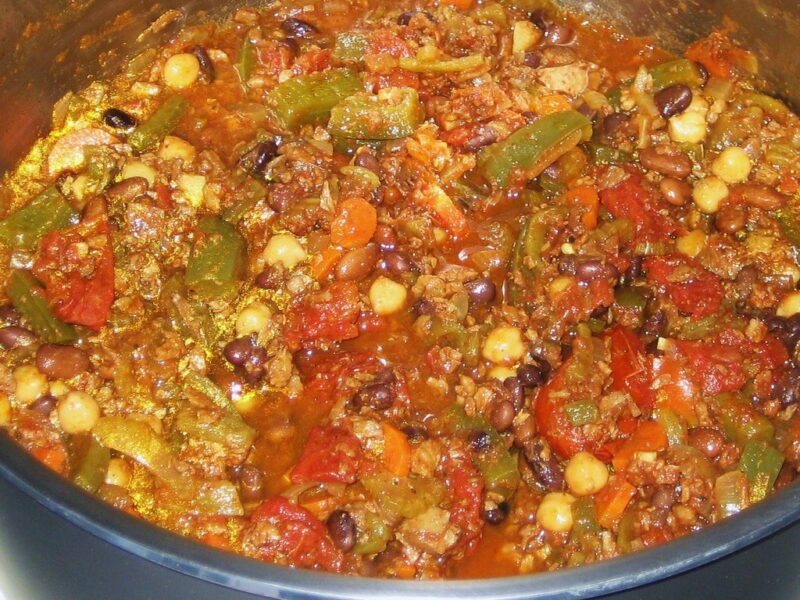
Cooking Method
Creating a delicious vegetarian chili can be a rewarding experience. The key to a flavorful chili lies in its cooking method. This guide will walk you through the steps of sautéing the base ingredients, simmering the chili, and the final mixing process, ensuring you end up with a mouth-watering dish.
Sautéing Base Ingredients
Begin by heating some olive oil in a large pot over medium heat. Sautéing the base ingredients is crucial as it helps to release their flavors. Start by adding chopped onions, garlic, and bell peppers to the pot. These ingredients form the flavor foundation of your chili.
Stir the vegetables frequently to prevent them from burning. Cook until the onions become translucent and the peppers are soft. This process usually takes about 5-7 minutes. Next, add your spices. Spices are the soul of any chili. Common spices include chili powder, cumin, and paprika. Here’s a simple table for reference:
| Spice | Quantity |
|---|---|
| Chili Powder | 2 tbsp |
| Cumin | 1 tbsp |
| Paprika | 1 tbsp |
Stir the spices into the sautéed vegetables. This step ensures the spices infuse their flavors into the base ingredients. Continue cooking for another 2-3 minutes, stirring constantly. 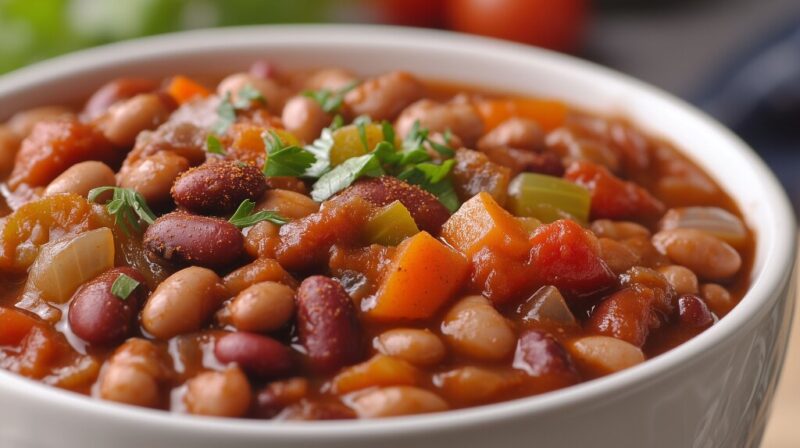
Simmering The Chili
Once the base ingredients are well sautéed, it’s time to add the remaining ingredients and let them simmer. Pour in a can of diced tomatoes and vegetable broth. These liquids will create the sauce for your chili.
Add in your choice of beans. Common options include black beans, kidney beans, and pinto beans. You can use a combination of these for a more complex flavor. Here’s a quick list of ingredients to add at this stage:
- 1 can of diced tomatoes
- 2 cups of vegetable broth
- 1 can of black beans (drained and rinsed)
- 1 can of kidney beans (drained and rinsed)
- 1 can of pinto beans (drained and rinsed)
Stir everything together and bring the mixture to a boil. Once boiling, reduce the heat to low. Simmer the chili for at least 30 minutes, allowing the flavors to meld together. Stir occasionally to prevent sticking and ensure even cooking.
Final Mixing
After simmering, the chili will be rich and flavorful. Now, it’s time for the final mixing stage. Add in any additional ingredients such as corn, carrots, or zucchini. These ingredients add texture and enhance the nutritional value of your chili.
Season your chili with salt and pepper to taste. Taste the chili and adjust the seasoning if needed. This step is crucial for achieving the perfect balance of flavors. If you prefer a thicker chili, you can mash some of the beans with a potato masher directly in the pot. This will give the chili a heartier consistency.
Serve your vegetarian chili hot, garnished with fresh cilantro, avocado slices, or shredded cheese. Enjoy the fruits of your labor with a bowl of warm, comforting chili!
Tips For Serving Vegetarian Chili
Vegetarian chili is a hearty and flavorful dish that can be enjoyed in many ways. Whether you are hosting a party or having a quiet dinner at home, serving suggestions can elevate your chili experience. This section will guide you through the best ways to present and enjoy your vegetarian chili.
Toppings And Garnishes
Enhancing your vegetarian chili with the right toppings and garnishes can make it even more delicious. Here are some popular options:
- Shredded cheese: Cheddar or Monterey Jack adds a creamy texture.
- Sour cream: A dollop of sour cream gives a tangy flavor.
- Chopped cilantro: Fresh cilantro adds a burst of freshness.
- Diced onions: Raw or sautéed onions provide a crunchy bite.
- Sliced jalapeños: For those who like it spicy.
- Avocado slices: Creamy avocado balances the heat.
For a unique twist, consider using:
- Crumbled tortilla chips: Adds a delightful crunch.
- Pickled jalapeños: Offers a tangy, spicy kick.
- Hot sauce: Perfect for spice lovers.
Pairing With Sides
Pairing your vegetarian chili with the right sides can create a well-rounded meal. Here are some great options:
- Rice: White or brown rice absorbs the chili flavors well.
- Quinoa: A protein-packed alternative to rice.
- Cornbread: Sweet and moist, it complements the savory chili.
- Garlic bread: Adds a delicious, garlicky crunch.
- Salad: A fresh green salad balances the heaviness of the chili.
For a more indulgent meal, consider these sides:
- Loaded baked potatoes: Top with chili and your favorite toppings.
- Nachos: Layer chili over tortilla chips with melted cheese.
- Grilled vegetables: A healthy and flavorful choice.
Serving Bowls
The right serving bowls can enhance your dining experience. Consider the following options:
- Ceramic bowls: Retain heat and keep your chili warm.
- Bread bowls: Edible and fun, perfect for a cozy meal.
- Stoneware bowls: Durable and stylish, ideal for serving guests.
For a more casual setting, try:
- Mugs: Great for a cozy, handheld option.
- Disposable bowls: Convenient for parties and easy cleanup.
To add a touch of elegance, use:
- Porcelain bowls: Classic and timeless, perfect for formal dinners.
- Glass bowls: Showcase the vibrant colors of your chili.
Consider these tips for the best presentation:
- Garnish just before serving: Keeps toppings fresh and vibrant.
- Use contrasting colors: Makes the dish visually appealing.
- Serve with a side of toppings: Allows guests to customize their bowls.
Storage Tips For Vegetarian Chili Recipe
Vegetarian chili is a hearty and delicious meal that can be enjoyed for days. Knowing how to store it properly ensures you can savor every bite. Here are some essential storage tips to keep your vegetarian chili fresh and tasty.
Refrigeration
Proper refrigeration keeps your vegetarian chili fresh for up to five days. Follow these steps to store it effectively:
- Cool it down: Allow the chili to cool at room temperature before storing it in the fridge.
- Use airtight containers: Transfer the chili to airtight containers to maintain its flavor and prevent contamination.
- Label and date: Label the containers with the date to keep track of freshness.
Freezing Options
Freezing your vegetarian chili extends its shelf life to up to three months. Follow these steps to freeze it properly:
- Cool completely: Let the chili cool down entirely before freezing.
- Use freezer-safe containers: Store the chili in freezer-safe bags or containers to avoid freezer burn.
- Leave space: Leave some space at the top of the container for the chili to expand as it freezes.
- Label and date: Write the date and contents on the container to keep track of storage time.
Reheating Methods
Reheating your vegetarian chili is simple and quick. Here are some methods to ensure it tastes as good as new:
- Stovetop: Place the chili in a pot and heat it over medium heat. Stir occasionally until it’s hot all the way through.
- Microwave: Transfer a portion to a microwave-safe bowl. Cover it with a microwave-safe lid or plate and heat in 1-minute intervals, stirring between each interval.
- Oven: Preheat the oven to 350°F (175°C). Place the chili in an oven-safe dish, cover it with foil, and heat for about 20-30 minutes.
Nutritional Benefits of Vegetarian Chili Recipe
Vegetarian chili is not just a delicious dish, but it’s also packed with nutritional benefits. This hearty meal can be both satisfying and nourishing. Let’s delve into the nutritional perks of this wonderful recipe.
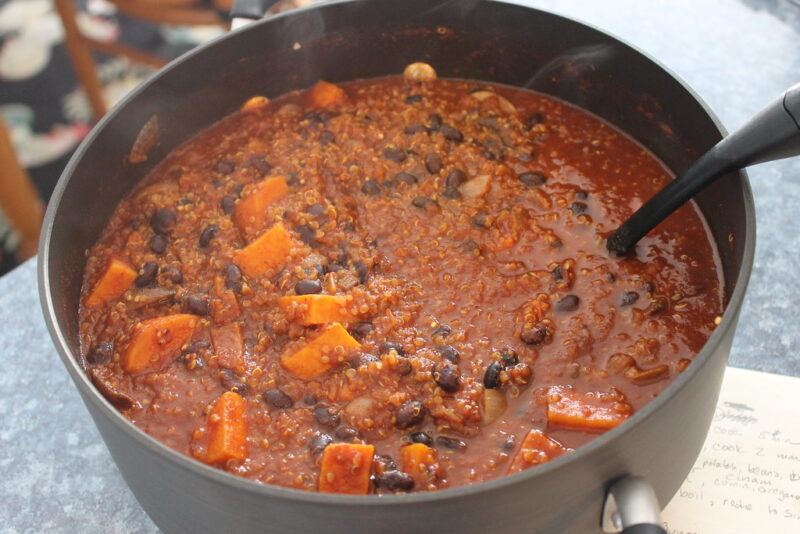
High Fiber Content
Fiber is crucial for a healthy digestive system. A vegetarian chili is loaded with ingredients that are rich in fiber. Here are some high-fiber ingredients typically found in vegetarian chili:
- Beans: Kidney beans, black beans, and chickpeas
- Vegetables: Bell peppers, carrots, and corn
- Whole Grains: Quinoa or brown rice
Fiber helps in regulating bowel movements and can prevent constipation. It also plays a role in maintaining a healthy weight. A bowl of vegetarian chili can provide up to 25% of the daily recommended fiber intake. Here is a table showcasing the fiber content of common chili ingredients:
| Ingredient | Fiber Content (per cup) |
|---|---|
| Kidney Beans | 13g |
| Black Beans | 15g |
| Carrots | 4g |
| Bell Peppers | 3g |
Protein Sources
Protein is essential for muscle repair and growth. Vegetarian chili can be a great source of plant-based protein. Some excellent protein sources in vegetarian chili include:
- Beans: Black beans, kidney beans, and pinto beans
- Legumes: Lentils and chickpeas
- Quinoa: A complete protein containing all nine essential amino acids
A single serving of vegetarian chili can provide up to 15 grams of protein. This makes it a fantastic option for those on a vegetarian or vegan diet. Check out the protein content in some of the common ingredients:
| Ingredient | Protein Content (per cup) |
|---|---|
| Black Beans | 15g |
| Kidney Beans | 13g |
| Chickpeas | 14g |
| Quinoa | 8g |
Vitamins And Minerals
Vegetarian chili is a treasure trove of essential vitamins and minerals that support overall health. The variety of vegetables and legumes ensure a rich nutrient profile. Here are some key vitamins and minerals found in vegetarian chili:
- Vitamin C: Bell peppers and tomatoes
- Vitamin A: Carrots and sweet potatoes
- Iron: Beans and lentils
- Magnesium: Black beans and spinach
- Potassium: Tomatoes and beans
These nutrients are vital for boosting immunity, improving vision, and maintaining strong bones. A balanced vegetarian chili can contribute significantly to your daily nutritional requirements.
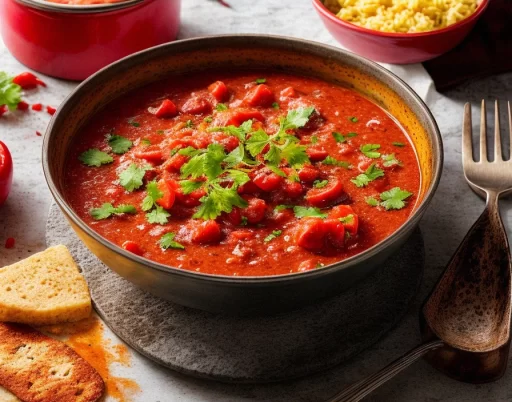
Variations To Try To Prepare Vegetarian Chili Recipe
Vegetarian chili is a hearty and delicious dish that’s perfect for any meal. With its rich flavors and versatility, you can make it in many ways. Here are some exciting variations to try to keep your vegetarian chili fresh and fun.
Spicy Versions
For those who love a kick in their meals, spicy vegetarian chili is a must-try. There are several ways to add heat:
- Jalapeños: Finely chop jalapeños and add them to your chili for a fresh, fiery flavor.
- Red Pepper Flakes: Sprinkle red pepper flakes to increase the spice level gradually.
- Cayenne Pepper: A small amount goes a long way in adding heat.
- Hot Sauce: Add a few dashes of your favorite hot sauce for a tangy spice.
Here’s a simple table to help you decide how much spice to add:
| Spice Ingredient | Quantity | Heat Level |
|---|---|---|
| Jalapeños | 1-2, chopped | Medium |
| Red Pepper Flakes | 1 tsp | High |
| Cayenne Pepper | 1/4 tsp | Very High |
| Hot Sauce | 2-3 dashes | Medium to High |
Different Beans
Beans are the backbone of any vegetarian chili. Experiment with different types to vary the texture and flavor:
- Black Beans: These beans add a rich, earthy taste and a dark color.
- Kidney Beans: Traditional in chili, they hold their shape well.
- Pinto Beans: Soft and creamy, they absorb flavors beautifully.
- Chickpeas: Add a unique texture and a nutty flavor.
Mixing beans is a great way to enhance your chili. Here’s a combination idea:
| Bean Type | Quantity | Notes |
|---|---|---|
| Black Beans | 1 cup | Rich and dark |
| Kidney Beans | 1 cup | Firm texture |
| Pinto Beans | 1 cup | Creamy |
| Chickpeas | 1/2 cup | Nutty flavor |
Add Grains To Bring Variety In Vegetarian Chili Recipe
Grains can add a hearty texture and extra nutrition to your vegetarian chili. Consider these options:
- Quinoa: This grain is high in protein and adds a slight crunch.
- Bulgur: It has a chewy texture and absorbs flavors well.
- Barley: Adds a nutty flavor and a chewy texture.
- Brown Rice: Makes the chili more filling and adds a subtle flavor.
Here’s a guide on how to incorporate grains into your chili:
| Grain Type | Quantity | Cooking Time |
|---|---|---|
| Quinoa | 1 cup, cooked | 15 minutes |
| Bulgur | 1 cup, cooked | 12 minutes |
| Barley | 1 cup, cooked | 25 minutes |
| Brown Rice | 1 cup, cooked | 20 minutes |
Popular Option To Pair With Vegetarian Recipe
Creating the perfect Vegetarian Chili Recipe is an art. The right accompaniments can elevate the dish. Let’s explore some popular options that pair wonderfully with vegetarian chili. These sides not only complement the flavors but also enhance the overall dining experience.
Cornbread
Cornbread is a classic side that pairs perfectly with vegetarian chili. Its slightly sweet flavor balances the spiciness of the chili. The crumbly texture soaks up the chili’s sauce, creating a delightful bite.
To make cornbread, you need:
- 1 cup of cornmeal
- 1 cup of all-purpose flour
- 1/4 cup of sugar
- 1 tablespoon of baking powder
- 1/2 teaspoon of salt
- 1 cup of milk
- 1/4 cup of vegetable oil
- 1 egg
Mix the dry ingredients in one bowl and the wet ingredients in another. Combine them and bake at 400°F for 20 minutes. Enjoy warm cornbread with your chili.
A table of cornbread variations:
| Variation | Additional Ingredients |
|---|---|
| Cheese Cornbread | 1 cup shredded cheddar cheese |
| Jalapeño Cornbread | 1 diced jalapeño |
| Honey Cornbread | 2 tablespoons honey |
Rice
Rice is another fantastic accompaniment for vegetarian chili. It adds a starchy balance to the meal and helps in soaking up the chili’s rich sauce.
Types of rice to consider:
- White Rice: Simple and classic.
- Brown Rice: Nutty flavor and high in fiber.
- Wild Rice: Unique texture and earthy taste.
Cooking rice is easy:
- Rinse the rice to remove excess starch.
- Use a 2:1 water-to-rice ratio.
- Bring water to a boil, add rice, reduce heat, and cover.
- Simmer for 18-20 minutes.
For added flavor, cook the rice in vegetable broth instead of water. This gives it a richer taste that complements the chili well.
Avocado Slices
Avocado slices add a creamy texture and fresh flavor to vegetarian chili. The richness of avocado contrasts beautifully with the spicy and tangy notes of the chili.
How to prepare avocado slices:
- Choose ripe avocados. They should yield slightly to pressure.
- Cut the avocado in half, remove the pit, and slice the flesh.
- Sprinkle with a pinch of salt and a squeeze of lime.
Avocado slices can be served on top of the chili or on the side. They add a nutritional boost with healthy fats, vitamins, and minerals. For a creative twist, try these variations:
| Variation | Additional Ingredients |
|---|---|
| Spicy Avocado | Red pepper flakes |
| Herb Avocado | Chopped cilantro |
| Garlic Avocado | Minced garlic |
Frequently Asked Questions
What Ingredients Are In Vegetarian Chili?
Vegetarian chili typically includes beans, tomatoes, bell peppers, onions, and spices. You can also add corn, zucchini, and carrots. For extra protein, consider using tofu or tempeh. Spices like cumin, chili powder, and paprika add flavor.
How Do You Make Vegetarian Chili Spicy?
To make vegetarian chili spicy, add jalapeños, hot sauce, or cayenne pepper. You can also use spicy chili powder or crushed red pepper flakes. Adjust the heat level to your preference.
Can You Freeze Vegetarian Chili?
Yes, you can freeze vegetarian chili. Allow it to cool completely before transferring to airtight containers. It can be frozen for up to three months. Thaw and reheat when ready to eat.
What Can You Serve With Vegetarian Chili?
Serve vegetarian chili with rice, cornbread, or tortilla chips. Toppings like avocado, sour cream, and shredded cheese are popular. A side salad or crusty bread can also complement the meal.
Conclusion
This vegetarian chili recipe is perfect for any meal. It’s hearty, nutritious, and easy to make. Enjoy the rich flavors and health benefits. Share this recipe with friends and family, and let everyone savor the deliciousness. Don’t forget to experiment with your favorite vegetables and spices.
Happy cooking!

